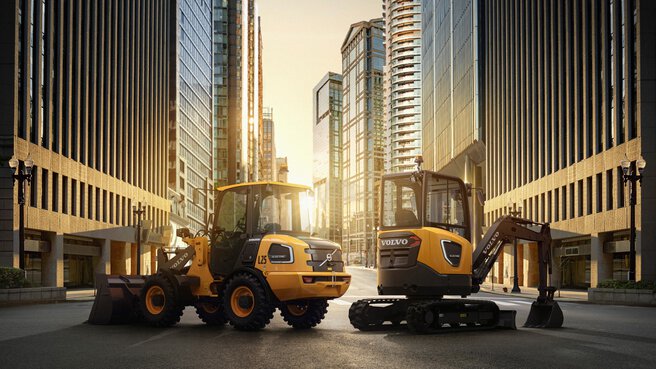Electric construction machinery on the rise
- Environmentally conscious municipalities important market drivers
- E-solutions particularly in smaller power ranges
- Load cycles as a decisive application criterion
- Hybrid, hydrogen and biofuels as alternatives
Low-emission driving and working is currently one of the main development goals of the construction machinery industry, with an international focus on battery-electric drives.
The electrification of construction machinery is making quick progress. Last year saw a whole range of new products reaching the market as well. For example Munich-based manufacturer Wacker Neuson launched the EZ17e mini excavator as a series product. The machines were already on display at bauma the year before—the international construction machinery trade show in Munich. “At bauma 2019, we focused on zero emissions: the trade fair was the perfect platform to showcase our EZ17e as another piece of the puzzle for completely emission-free construction sites,” says Alexander Greschner, CSO of the Wacker Neuson Group.
Since 2020, CASE Construction Equipment also has an electric construction machine in its portfolio. The 580 EV is not only a first for the U.S. manufacturer, it also is the world's first all-electric backhoe loader.
In the small power range...
In the drives of construction machinery, electrics and hydraulics are currently in healthy competition, according to Prof. Dr.-Ing. Marcus Geimer. “However, I still see electric drives in rather smaller power ranges of up to a maximum of 20 kilowatts,” says the head of the Mobile Machinery section of the Karlsruhe Institute of Technology (KIT). Which does not mean that—in individual cases and with sophisticated concepts—completely different dimensions can be achieved. “For e-solutions to be successful, the load cycles and the tasks of the machines count,” the professor clarifies.
... or very big with a customized concept
According to him, this has been exemplarily demonstrated in Switzerland with the eDumper. That's the name of a Komatsu dump truck that research and industry partners converted into the world's largest e-battery vehicle. Since 2018, it has been transporting up to 65 tons of lime and marl rock per trip from a higher-lying quarry in Péry in the Bernese Jura to a lower-lying processing plant. During the fully loaded descent, the energy storage is recharged by means of recuperation of the braking energy. According to Lithium System GmbH (Illnau/Switzerland), which for example supplied the vehicle's 4.5-ton battery, about the same amount of electricity is generated during the descent as is needed for the ascent. An even larger version of the eDumper with a load capacity of 100 tons is currently being planned.
Also promoting other drive alternatives
Despite all the enthusiasm for quiet and at least locally emission-free electromobility: if emissions from construction equipment fleets as a whole are to be further reduced, other technologies must also be advanced. Prof. Geimer: “In addition to other hybrid solutions, there is currently a great deal of research being done on hydrogen vehicles with fuel cells, for example. One of the problems to be solved is the tank space, since hydrogen requires a significantly larger volume than diesel for the same energy content. Furthermore, we should keep in mind the possible use of CO2-neutral biogenic fuels—especially for the very large machines and vehicles."
“The road to zero emissions” was one of the central themes of bauma 2022. The World’s Leading Trade Fair for Construction, Building Material and Mining Machines and Construction Vehicles and Equipment took place from October 24 until 30, 2022 at the Munich trade fair center.








